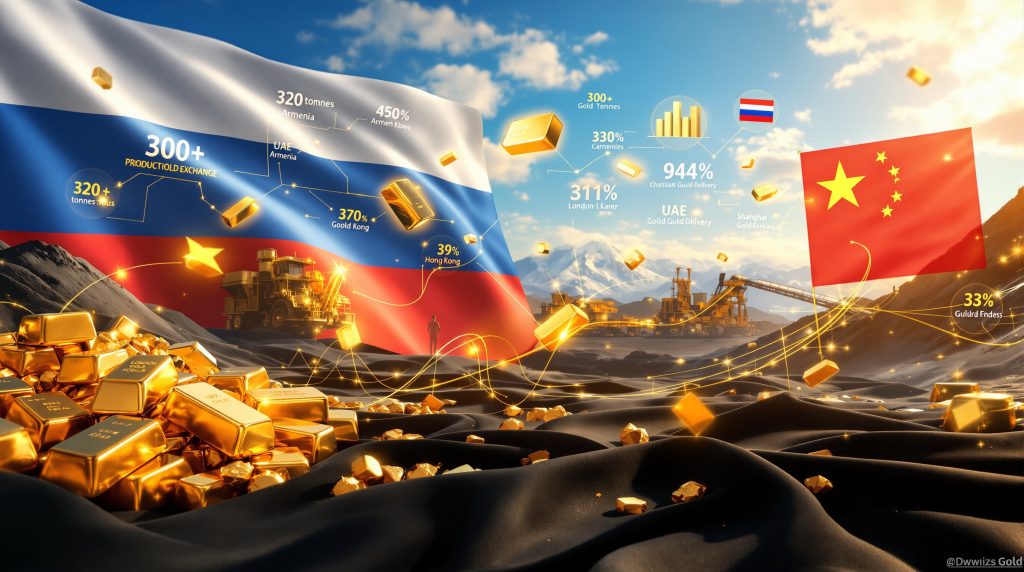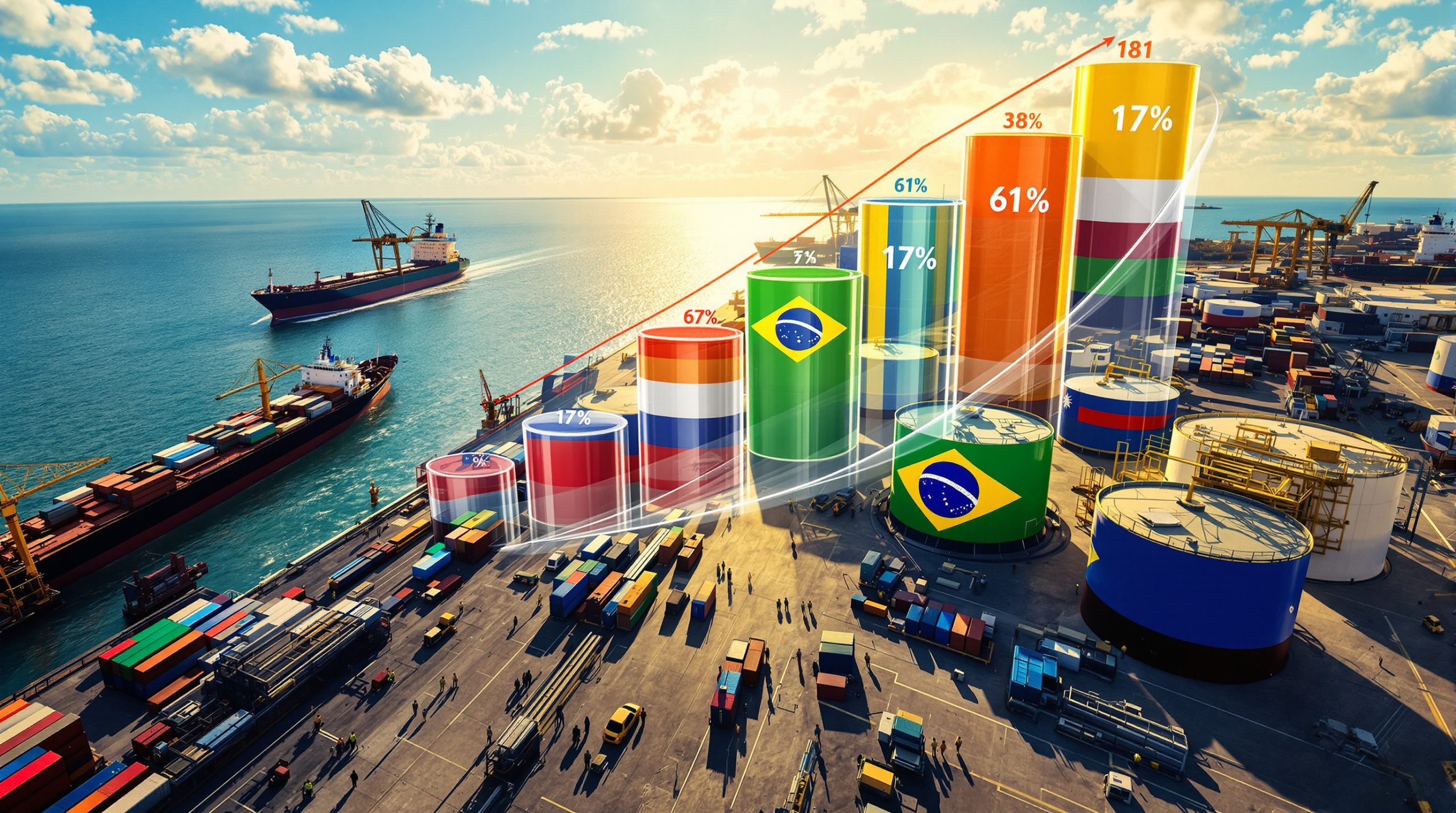What Makes Russia a Global Gold Production Powerhouse?
Russia stands as one of the world's most significant gold producers, consistently ranking second globally behind China. Where is russia's gold production going has become a critical question as geopolitical shifts reshape global precious metals trade. According to the U.S. Geological Survey's 2023 Mineral Commodity Summary, Russia produces approximately 300-330 tonnes of gold annually, representing a substantial portion of global supply.
This production capacity stems from the country's vast geological endowment across Siberian and Far Eastern territories. Furthermore, extensive hard-rock deposits have been developed over decades of mining operations, establishing Russia's position in the global gold hierarchy.
Russia's Position in the Global Gold Mining Hierarchy
The Russian Federation's mining regions span multiple federal subjects, with Eastern Siberia and the Far East serving as primary production centres. Key areas include Magadan Oblast, Chukotka Autonomous Okrug, and Yamal-Nenets Autonomous Okrug, where geological surveys have identified substantial gold-bearing ore bodies.
These regions benefit from established transportation infrastructure and processing facilities that support large-scale extraction operations. In addition, the distribution creates natural advantages for accessing both domestic and international markets.
Major Russian Gold Mining Operations and Their Output
The Russian gold mining sector encompasses both large-scale industrial operations and smaller regional producers. Major companies like Polyus Gold and Highland Gold Mining operate sophisticated extraction facilities utilising modern technologies including heap leaching, flotation processing, and cyanide recovery systems.
Despite equipment restrictions imposed through international sanctions, Russian mining operations have maintained technological capabilities through domestic engineering solutions. Consequently, alternative supply chains have become crucial for sustained production levels.
Production capacity varies significantly across different regions, with some areas contributing over 50 tonnes annually while others operate smaller-scale operations. However, mining companies have adapted operational strategies to maintain production levels despite external pressures.
How Have Sanctions Transformed Russia's Gold Export Strategy?
The Pre-2022 Export Framework vs. Current Reality
Before February 2022, Russian gold exports followed established Western market pathways, with significant volumes flowing to London, New York, and other major trading centres. The London Bullion Market Association's Good Delivery standards served as the primary certification mechanism, enabling Russian-produced gold to access international markets.
Traditional export relationships relied heavily on Western financial institutions and clearing mechanisms. Russian gold reached global markets through established supply chains that included transportation to European refineries, processing to meet London Good Delivery specifications, and distribution through international bullion dealers.
The transformation following sanctions implementation created fundamental disruptions to these established patterns. Western restrictions on precious metals trade forced Russian producers to seek alternative certification pathways and develop new market access strategies.
Immediate Market Adaptations and New Trade Patterns
Russian gold exporters implemented rapid strategic pivots to maintain market access. Alternative certification standards emerged as crucial mechanisms, particularly through Asian trading platforms that operated independently of Western regulatory frameworks.
The Shanghai Gold Exchange became increasingly important as a venue for price discovery and transaction settlement outside traditional Western-dominated systems. Moreover, this shift demonstrated the robust gold market performance capabilities of alternative trading infrastructure.
Export methodology shifted from direct Western market access to complex multi-stage processes involving intermediary countries and alternative trading platforms. These adaptations required significant logistical coordination and the development of new financial settlement mechanisms.
Where Does the Majority of Russian Gold Flow Today?
China as the Primary Destination Market
China has emerged as the dominant destination for Russian gold exports, absorbing substantial volumes through both direct and indirect trading mechanisms. The Shanghai Gold Exchange serves as a critical infrastructure component, providing price discovery and settlement services for Russian-origin gold entering Chinese markets.
Chinese precious metals imports from Russia have shown significant increases, though official statistics often aggregate precious metals categories. Chinese Customs data indicates substantial growth in precious metals trade with Russia, reflecting the strategic importance of this bilateral relationship.
The Chinese market absorption capacity represents a crucial factor in Russian export strategy. Furthermore, China's domestic gold consumption, including industrial applications, jewellery manufacturing, and investment demand, provides substantial volume capacity for Russian production.
The Complex Web of Indirect Trade Routes
Russian gold reaches international markets through sophisticated indirect trading networks that involve multiple intermediary countries. These complex routes serve various functions, including regulatory arbitrage, logistical consolidation, and market access facilitation.
Armenia has reportedly emerged as a significant transit hub since mid-2023, serving as a gateway between Russian production and ultimate destination markets. The country's membership in the Eurasian Economic Union provides regulatory advantages for Russian gold transit, while its geographic position enables efficient transportation to Middle Eastern and Asian markets.
The United Arab Emirates, particularly Dubai's precious metals infrastructure, plays a crucial role in regional gold redistribution. Dubai's Multi Commodities Centre (DMCC) maintains extensive refining and trading capabilities, enabling processing and certification of gold from various sources.
Hong Kong continues its historical role as a major Asian precious metals trading centre, providing liquidity and price discovery mechanisms for regional gold flows. The territory's financial infrastructure and regulatory framework support substantial precious metals trading volumes.
| Estimated Russian Gold Flow Distribution |
|---|
| Destination |
| China Direct |
| China Indirect |
| UAE |
| Hong Kong |
| Armenia |
Which Countries Serve as Key Intermediary Markets?
Armenia's Strategic Position in the Gold Trade Network
Armenia's geographic location and membership in the Eurasian Economic Union create unique advantages for facilitating Russian gold transit. The country serves as a bridge between Russian production centres and international markets, particularly those in the Middle East and Asia.
Transportation logistics from Russia to Armenia utilise established trade routes that have operated for decades. In addition, this provides reliable infrastructure for precious metals movement whilst maintaining compliance with EEU trading standards.
Processing capabilities within Armenia include basic handling and documentation services that support international trade requirements. However, its role as a transit hub provides essential logistical coordination for Russian gold reaching international markets.
United Arab Emirates as a Global Redistribution Hub
The UAE, centred on Dubai's precious metals infrastructure, operates as one of the world's most significant gold trading and processing centres. DMCC facilities include extensive refining capabilities, quality testing laboratories, and trading infrastructure that supports substantial volume handling.
Dubai's regulatory environment provides advantages for international precious metals trading, with established frameworks for import, processing, and re-export activities. The emirate's geographic position between Asian and African markets creates natural advantages for regional gold distribution.
Processing infrastructure in the UAE includes modern refining facilities capable of transforming raw gold into various product formats meeting different international standards. Consequently, this capability proves essential for Russian gold requiring certification conversion or quality upgrading.
Hong Kong's Role in Asian Gold Distribution
Hong Kong maintains its traditional position as a major Asian precious metals trading centre, providing essential market infrastructure for regional gold flows. The territory's financial institutions, trading platforms, and regulatory frameworks support substantial precious metals transaction volumes.
Historical trading relationships between Hong Kong and mainland China create natural pathways for gold flowing into Chinese markets. These established connections provide infrastructure and expertise that facilitate large-volume precious metals transactions across the Hong Kong-China border.
The territory's role in international price discovery and market liquidity provision remains significant despite changing global trade patterns. Moreover, Hong Kong's precious metals infrastructure continues supporting regional trading activities, including transactions involving gold from Russian sources.
What Portion of Russian Gold Stays Within Domestic Markets?
Record Domestic Retail Demand Patterns
Russian domestic gold consumption has increased substantially, with citizens purchasing significant quantities of precious metals for personal investment and wealth preservation. This internal demand reflects multiple economic factors, including currency concerns, inflation hedging strategies, and traditional Russian cultural affinity for precious metals ownership.
Domestic retail gold products available to Russian consumers include:
- Gold bars in various weights (1g to 1kg denominations)
- Investment coins from the Russian Mint
- Digital gold accounts through domestic banking institutions
- Jewellery purchases serving dual ornamental and investment functions
The surge in domestic gold purchases represents a significant shift in Russian precious metals allocation. Previously, the majority of domestic production flowed to export markets or central bank reserves. Current patterns show increased retention within Russian borders, reflecting changed economic priorities and reduced export opportunities in traditional Western markets.
This trend aligns with broader understanding of gold as an inflation hedge amongst Russian consumers seeking wealth preservation options.
Central Bank Policy Shifts and Market Impact
The Bank of Russia historically maintained active gold purchase programmes, regularly acquiring domestic production to build official reserves. According to Bank of Russia statements, these systematic purchases contributed to substantial reserve accumulation over multiple years preceding 2022.
Following geopolitical developments in early 2022, central bank gold acquisition patterns shifted significantly. The cessation of regular official purchases released substantial gold volumes that previously flowed into reserves, making this production available for alternative uses.
This policy adjustment created increased availability for both export channels and domestic retail market supply. Russian citizens gained access to larger gold supplies at competitive pricing, whilst export operations could access additional volumes for international sales.
Reserve management strategy changes reflected broader economic policy adaptations:
- Reduced dependence on traditional Western clearing systems
- Increased focus on alternative asset allocation strategies
- Enhanced domestic market development priorities
- Strategic positioning for long-term economic independence
How Do Production Forecasts Shape Future Export Patterns?
Upcoming Production Capacity Expansions
Russian gold production capacity faces both expansion opportunities and development challenges in the coming years. Major projects under consideration include various regional developments across Siberian and Far Eastern territories, though specific timelines depend on multiple factors including financing availability and equipment access.
Infrastructure development supporting expanded production includes:
- Transportation network improvements connecting mining regions to processing centres
- Power generation capacity increases supporting energy-intensive operations
- Processing facility upgrades and new construction projects
- Alternative equipment sourcing arrangements replacing restricted Western technology
Production forecasting requires consideration of sanctions impacts on equipment availability, financing access, and technology transfer restrictions. However, Russian mining operations have adapted through domestic engineering capabilities, alternative supplier relationships, and operational optimisation strategies.
For investors seeking to understand where is russia's gold production going, examining these best gold investment strategies becomes crucial for portfolio planning.
Infrastructure Development Supporting Export Growth
Transportation infrastructure development focuses on connections between mining regions and alternative export pathways. Rail network improvements support ore and concentrate movement to processing facilities, whilst port infrastructure development enables access to non-Western shipping routes.
Processing facility development emphasises alternative certification pathway establishment. Russian refineries work toward compliance with non-Western quality standards, particularly those accepted by Asian trading platforms and destination markets.
Alternative equipment sourcing strategies address Western technology restrictions through domestic manufacturing development, Asian supplier relationships, and technological adaptation programmes. These initiatives support continued production capacity maintenance and potential expansion despite external equipment limitations.
What Role Does Russian Gold Play in BRICS Economic Strategy?
De-dollarisation Objectives and Gold Accumulation
Russian gold production aligns with broader BRICS alliance strategic objectives focused on reducing dependence on Western-dominated financial systems. Gold accumulation by BRICS member countries supports alternative reserve asset development and provides foundations for potential alternative payment mechanisms.
BRICS countries, including China, India, and others, maintain substantial gold reserves and continue accumulating precious metals through various channels. Russian gold production contributes to this collective strategy by providing supply for member country reserve building and supporting intra-BRICS trade settlement mechanisms.
The strategic importance of gold within BRICS economic planning reflects historical precedents and contemporary geopolitical considerations. Furthermore, precious metals provide value storage mechanisms that operate independently of Western monetary systems.
Geopolitical Implications of Redirected Gold Flows
Russian gold export redirection creates strengthened economic relationships with Asian partners and alternative trading bloc members. These enhanced connections provide foundations for expanded economic cooperation beyond precious metals trade, including energy cooperation and technology transfer.
Long-term strategic positioning through redirected gold flows includes:
- Enhanced economic integration with Asian markets
- Reduced dependence on Western trading infrastructure
- Development of alternative price discovery mechanisms
- Strengthened bilateral relationships with key partners
The impact on traditional precious metals trading centres includes reduced volumes flowing through London and New York markets. Consequently, corresponding increases occur in Shanghai, Dubai, and other alternative trading venues.
How Accurate Are Official Trade Statistics vs. Actual Flows?
Discrepancies in Reported vs. Estimated Volumes
Tracking Russian gold export volumes presents significant analytical challenges due to the complex nature of indirect trading routes and varying statistical reporting methodologies across different countries. Official customs statistics often aggregate precious metals categories, making specific gold volume determination difficult.
Methodological challenges in volume estimation include:
- Customs classification variations between countries
- Timing differences in shipment recording vs. receipt confirmation
- Processing and refining activities that transform product categories
- Confidentiality restrictions on commercial trading data
Chinese official import statistics provide one data point, but these figures may not capture the full scope of Russian gold reaching Chinese markets through indirect channels. Similarly, intermediary country export statistics may not clearly identify ultimate destination markets for re-exported Russian gold.
Methods for Estimating True Export Volumes
Industry analysts employ multiple data sources and cross-referencing methodologies to develop Russian gold export estimates. These approaches include customs data analysis from multiple countries, shipping and transportation tracking, and refinery input monitoring.
Cross-referencing techniques utilised in volume estimation:
- Bilateral trade data comparison between exporting and importing countries
- Transportation infrastructure utilisation analysis
- Market price correlation studies
- Regional supply-demand balance calculations
Statistical reconciliation requires consideration of processing delays, transportation timelines, and classification changes that occur during international gold trade. Analysts must account for refining activities, quality upgrades, and product format changes that affect how gold appears in different countries' trade statistics.
The accuracy of volume estimates improves through longer-term trend analysis rather than short-term monthly or quarterly assessments. However, seasonal variations, logistical delays, and administrative processing cycles create statistical noise that complicates precise volume determination.
What Are the Long-Term Implications for Global Gold Markets?
Structural Changes in International Gold Trading
The redirection of Russian gold flows represents a fundamental shift in global precious metals trading infrastructure, with long-term implications extending beyond current geopolitical circumstances. Traditional Western-centred trading mechanisms face reduced volumes, whilst Asian and alternative trading platforms experience increased activity.
Infrastructure development implications include:
- Expanded processing capacity in Asian trading centres
- Alternative certification standard development and recognition
- New transportation and logistics network establishment
- Regional price discovery mechanism evolution
London's historical dominance in global gold trading faces structural challenges as substantial volumes flow through alternative channels. This redistribution affects market liquidity, price discovery efficiency, and the concentration of trading activity across different time zones.
Shanghai Gold Exchange and other Asian trading platforms experience increased transaction volumes, necessitating infrastructure upgrades and capacity expansions. These developments support broader Asian economic integration objectives and reduce regional dependence on Western financial infrastructure.
Understanding these changes becomes essential when considering all-time high gold prices analysis and how supply chain shifts influence global markets.
Supply Chain Resilience and Market Adaptation
Global gold supply chain adaptation demonstrates market resilience and the ability of trading networks to evolve under changing circumstances. Alternative routing development, processing capability expansion, and new trading relationship establishment provide insights into precious metals market flexibility.
Market adaptation mechanisms observed include:
- Rapid development of alternative trading relationships
- Infrastructure capacity expansion in non-traditional trading centres
- Regulatory framework modifications to accommodate changing trade flows
- Technology transfer and expertise development in emerging trading hubs
Long-term market structure evolution may result in more geographically distributed trading infrastructure, reduced concentration in traditional Western centres, and enhanced regional market development. These changes support increased market resilience through diversification.
The sustainability of current alternative trading patterns depends on multiple factors including geopolitical stability, infrastructure development success, and market participant adaptation effectiveness. Continued evolution in global gold trading structures appears likely regardless of near-term political developments.
For investors monitoring where is russia's gold production going, understanding the gold-stock market relationship becomes increasingly important as traditional trading patterns evolve.
According to research from The Conversation, Putin's gold strategy has played a significant role in Russia's economic resilience. Furthermore, analysis from Mining.com reveals that Russian citizens are hoarding gold equal to Spain's reserves, highlighting the domestic market's growing importance.
Disclaimer: This analysis is based on publicly available information and industry reporting. Gold trade flow estimates vary significantly between different analytical sources due to the complex nature of international precious metals trading and limited transparency in some market segments. Readers should consult multiple sources and exercise caution when making investment decisions based on trade flow analyses.
Looking to Position Yourself Ahead of Global Gold Market Shifts?
Discovery Alert's proprietary Discovery IQ model delivers real-time alerts on significant ASX mineral discoveries, instantly empowering subscribers to identify actionable opportunities as global precious metals markets evolve. Begin your 30-day free trial today and secure your market-leading advantage by visiting Discovery Alert's home page.




